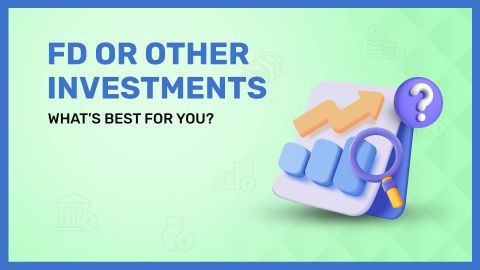With so many investment options out there, how do you know what’s right for you? Maybe you’re looking to grow your wealth but aren’t sure whether to go with something simple and accessible like mutual funds—or something more personalised and high-stakes like Portfolio Management Services (PMS).
It’s a common struggle. Mutual funds seem beginner-friendly, but you wonder if they’re enough to build serious wealth. PMS sounds more powerful, but the high minimum investment and risk can feel intimidating. If you’ve ever asked yourself, “What’s the difference, and which one makes sense for my goals?” you’re in the right place.
Before you decide where to invest, it is important to understand how each option fits your risk appetite, portfolio size, and financial goals not just what looks appealing on the surface. Compare Mutual Fund and PMS options now!
This article breaks down Mutual Funds vs PMS in plain terms from fees, risks, and transparency to who they’re meant for—so you can make an informed decision that aligns with your investment journey.
What are mutual funds?
Mutual funds are one of the most accessible investment options available. They work by pooling money from multiple investors, which is then managed by a professional fund manager. The fund manager invests this pool in a variety of assets like equities, bonds, or gold, based on the fund’s objective.
Whether you are a first-time investor starting with Rs. 100 or someone looking to diversify, mutual funds offer simplicity, liquidity, and built-in diversification. Plus, the operational and management costs are minimal—just an expense ratio that’s deducted from your returns.
What is an index mutual fund?
Index mutual funds are a type of mutual fund designed to track a specific market index, such as the Nifty 50 or Sensex. They don’t aim to beat the market—they aim to mirror it. These funds hold the same stocks, in the same proportion, as the index they follow.
Because they don’t require active stock picking, index funds usually have lower management fees. They offer transparency, wide market exposure, and are especially useful for long-term investors looking for consistent, low-cost growth with minimal effort.
If you are seeking a low-cost, no-fuss way to invest in the entire market without constantly monitoring your portfolio, index mutual funds can be a smart starting point. Explore top index mutual fund schemes today!
What are portfolio management services?
Portfolio Management Services (PMS) are customised investment services designed primarily for high-net-worth individuals (HNIs). In PMS, a professional portfolio manager makes tailored investment decisions on your behalf, based on your financial goals, risk appetite, and personal preferences.
Unlike mutual funds—where investors buy units of a common fund—PMS clients own the actual securities in their name. The manager can buy or sell assets without needing your approval for every transaction. This gives you more control, flexibility, and personalisation, but it also means higher minimum investment amounts (typically Rs. 50 lakh) and steeper management fees.
Differences between mutual funds and portfolio management services
While both mutual funds and PMS help grow your money through market investments, they work very differently in terms of structure, access, and control:
Minimum Investment: Mutual funds are accessible to everyone (starting from Rs. 500), while PMS is built for HNIs with at least Rs. 50 lakh to invest.
Ownership: Mutual funds pool investor money; in PMS, you directly own the securities.
Flexibility: PMS offers full customisation, whereas mutual funds follow a standard strategy for all investors.
Transparency: PMS provides detailed reports and live tracking. Mutual funds disclose holdings less frequently.
Costs: PMS tends to have higher fees, including performance-linked charges, while mutual funds charge a small, fixed expense ratio.
Your decision between the two should reflect your investment budget, risk tolerance, and how involved you want to be in managing your money.
PMS vs Mutual Funds : Key differences in a comparison table
To make things even clearer, here’s a snapshot comparison:
Factors |
PMS |
Mutual Funds |
Investor Profile |
HNIs |
All investors |
Portfolio Size |
Large |
Small to medium |
Risk Appetite |
High |
Low to High |
Investment Horizon |
Long-term |
Short to long-term |
Customisation |
High |
Limited |
Transparency |
High |
Moderate |
Diversification |
Limited |
High |
Cost |
Higher |
Lower |
Best For |
Personalisation, control |
Simplicity, diversification |
Types of PMS
Portfolio Management Services (PMS) come in two primary forms:
Discretionary PMS: Here, the portfolio manager makes all the investment decisions for you. They decide what to buy or sell and when to do it, without needing your approval every time. This is ideal if you want expert control without being involved in day-to-day decisions.
Non-discretionary PMS: In this model, the portfolio manager only advises you on what to invest in, but the final call is yours. You approve each transaction. This suits investors who want expert guidance but still wish to retain control over their portfolio.
Types of mutual funds
Mutual funds offer a wide variety of choices for investors with different goals and risk appetites. Some common types include:
Equity Funds: These invest in stocks and aim for high growth. They carry more risk but can offer higher returns over the long term.
Debt Funds: These are low-to-medium risk options that invest in fixed income instruments like bonds and treasury bills. They offer more stability.
Hybrid Funds: A mix of equity and debt, these aim to balance risk and reward. Great for investors who want both growth and stability.
Index Funds: These mimic market indices like Nifty 50 or Sensex and offer low-cost exposure to the broader market.
Sector/Thematic Funds: These invest in specific sectors like pharma, banking, or technology. They can offer high returns but are riskier due to sector concentration.
Each mutual fund type is designed for a specific investment style, so it is important to match your choice with your goals and risk tolerance. Compare Mutual Fund Options Now
Factors to consider before investing in mutual funds
Before putting your money into mutual funds, take a moment to assess these key factors:
Investment Goal: Are you investing to build long-term wealth, generate regular income, or save on taxes? Your goal will help you choose the right mutual fund category.
Risk Profile: Understand how much risk you're comfortable with. Equity funds carry more risk, while debt funds offer more stability.
Performance: Review the past performance of the fund over 5–10 years. While it’s not a guarantee of future results, it gives a sense of how the fund responds to market ups and downs.
Cost: Look at the fund’s expense ratio. A lower expense ratio means fewer charges eating into your returns especially important for long-term investors.
Factors to consider before investing in PMS
If you're thinking about investing in a Portfolio Management Service (PMS), here are some important things to keep in mind:
Risk appetite: PMS involves higher risk than mutual funds. Since the portfolio manager has the freedom to take bold positions, your investments may face sharper ups and downs. Only go for PMS if you’re comfortable with volatility and have the financial cushion to absorb potential losses.
Investment horizon: PMS usually works best for long-term investors. You might not see results in a year or two. Ideally, you should have a horizon of at least 3–5 years, giving the portfolio manager enough time to deliver results.
Cost: PMS typically charges more than mutual funds. Besides fixed management fees, you may have to pay a performance fee, custodial fee, and other expenses. Make sure you understand the cost structure and are okay with it.
Track record: Always check the portfolio manager’s credentials and performance history. Look at how they’ve managed risk, their consistency, and whether their investment philosophy aligns with your financial goals.
Should you invest in PMS as well as mutual funds?
This isn’t an either/or situation it depends on your financial standing and goals.
PMS is great if you are a high-net-worth individual (HNI) looking for tailored investment solutions, more direct control, and potentially higher returns. It’s designed for those who can invest a larger amount and are okay with higher risk.
Mutual Funds, on the other hand, are ideal for everyday investors. They offer diversification, ease of entry, and are heavily regulated making them accessible and lower-risk.
If you have a large portfolio and want to diversify how your money is managed, you could consider allocating a portion to PMS and the rest to mutual funds. Just make sure your overall investment strategy remains aligned with your long-term goals. Explore Top-Performing Mutual Funds!
Conclusion
Mutual funds and Portfolio Management Services serve different kinds of investors. Mutual funds are accessible, low-cost, and perfect for those seeking simplicity and diversification. PMS, on the other hand, caters to wealthy individuals who want a more hands-on, customised approach to investing.
Choosing between the two depends on how much you are willing to invest, your appetite for risk, and your expectations from the portfolio. Whether you prefer the ease of mutual funds or the personalised touch of PMS, the most important thing is to ensure your investments are aligned with your financial goals and capacity to take on risk.


